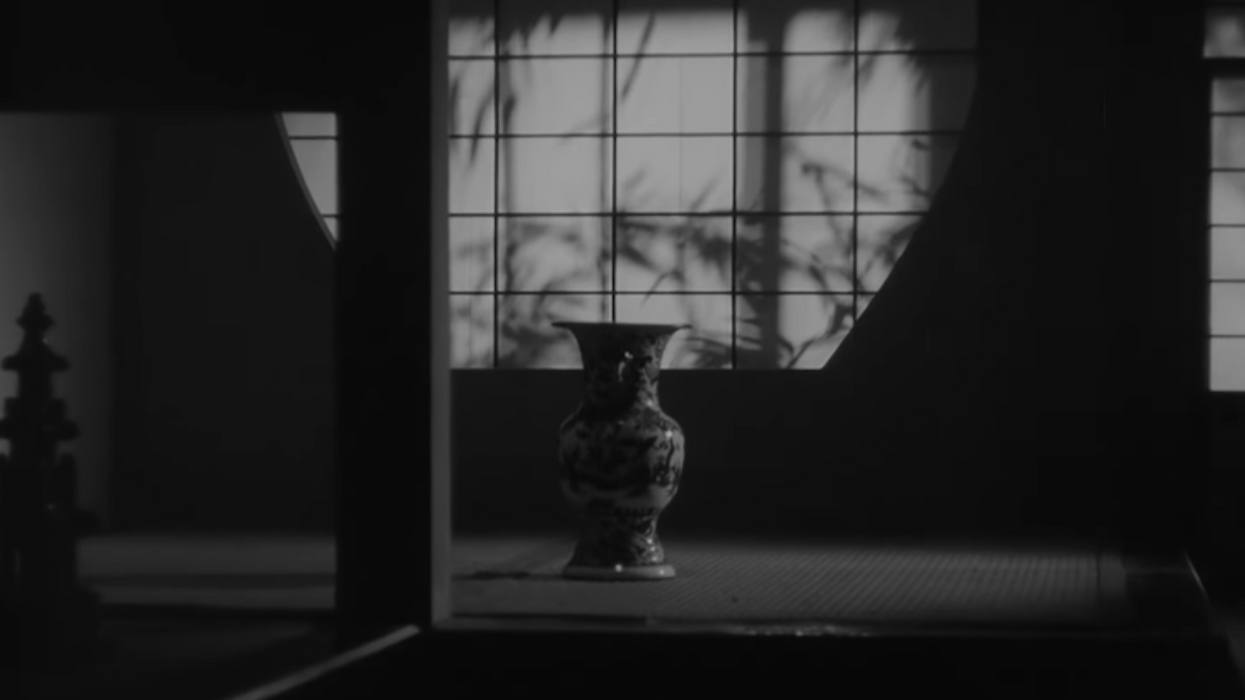Why Would Ozu Cut to a Vase at the End of This Scene?
Yasujirō Ozu is an enigmatic filmmaker who values mood and pacing. So why did he cut to this vase?

Ozu is one of those directors whose work inspired everyone who came after him. He was working at the same time as Welles and Curtiz, making movies that were just as important—movies about life, death, family, and marriage that were serene, melodic celebrations of nature and humanity that unfold slowly—a cinematic style that helped turn Ozu into a legend in film.
His film Late Spring falls perfectly into all of these topics. It's about a woman reluctantly choosing to get married because she thinks it's what her father wants. Her father pushes for his daughter’s marriage because he thinks that’s what she wants.
Late Spring has been referred to as the director's "most perfect" work, and as "the definitive film of Ozu's master filmmaking approach and language."
But one key scene has always baffled viewers. Toward the end of the film, as the daughter accepts her life will be changing, the camera cuts to a vase. This is one of the most powerful and enigmatic shots in Ozu’s entire filmography.
People call it a "pillow shot," but what does that mean?
And what could a vase mean to this character's journey, and what can it mean to the audience watching?
Check out this video essay from Evan Puschak, aka Nerdwriter, and let's talk after the jump.
Why Would Ozu Cut to a Vase at the End of This Scene?
First things first, we need to talk about "pillow shots."
A pillow shot is a cutaway, for no obvious narrative reason, to a visual element, often a landscape or an empty room, that is held for a significant time (five or six seconds). It can be at the start of a scene or during a scene.
Ozu was famous for these kinds of shots. They depict kettles and vases, but also pagodas, clothesline, street signs, smokestacks—always things, never people. Still, these shots underscore Ozu’s powerful belief in humanity.
As we know, editing is about assembling images for the film that help tell the story. It's not about just cutting between shots—you have to layer in ideas, as well. So without beating around the bush, here's the big question: why did Ozu cut to the vase? What does this object have to say about the scene, the themes, and the story?
How did we get to this question?
Ozu was often overlooked until Paul Schrader elevated Ozu in his 1972 book Transcendental Style in Film.
He wrote, “Perhaps the finest image of stasis in Ozu’s films is the lengthy shot of the vase in a darkened room near the end of Late Spring. [...] The father and daughter are preparing to spend their last night under the same roof; she will soon be married. They calmly talk about what a nice day they had, as if it were any other day. The room is dark; the daughter asks a question of the father, but gets no answer. There is a shot of the father asleep, a shot of the daughter looking at him, a shot of the vase in the alcove and over it the sound of the father snoring. Then there is a shot of the daughter half-smiling, then a lengthy, ten-second shot of the vase again, and a return to the daughter now almost in tears, and a final return to the vase.”
What does it all mean?
Schrader sees it as stasis itself, “a form which can accept deep, contradictory emotion and transform it into an expression of something unified, permanent, transcendent.”
And as Puschak says in the video, the edit “speaks to the unique power that Ozu has, that he developed over his long career. His style may appear simple, but is in fact so fine-tuned, so carefully calibrated, that he has the power to overwhelm the viewer, to launch a thousand interpretations with a single cut.”
Many scholars have talked about the vase, and there is no definite answer. Everyone is supposed to come up with their own because film is a subjective medium. But I can tell you that I think the vase represents the daughter's mother.
This is an arranged marriage, just like her mother had. It will carry her into her future, and someday she might have her own daughter, who has their marriage arranged as well. This is the tradition of the culture, just like it is tradition to hand down your goods to your offspring when you pass away.
I think she sees the vase as her mortality, like once she leaves this family, that's all that will be left of her.
But that's just me. Let me know what you think in the comments.
Source: Nerdwriter













